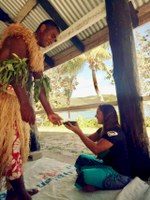Fiji: Cultural Protocols for Visiting Yachts
Fiji has a rich cultural history and many of their ancient traditions are alive and well today particularly in some of the farther-flung islands where cruisers like to explore.
By Georgia Gremore — Mar 29, 2019
Published 6 years ago


- Fijian Culture – Photo from Rebecca Prasse
Cruising in Fiji
One of the highlights of cruising in Fiji is learning about the Fijian culture and meeting the friendly locals.
This is sometimes a little intimidating if you don’t know the rules. Consider poor, nervous captain Bligh who opted to drift straight past all of Fiji on his lifeboat rather than risk offending the locals…
Fear not! The days of cannibalism are well gone, though the Fijian people are no less likely to invite you in for meal.
Fijian Cuisine
Sharing food is an important part of Fijian culture. If you meet someone who is eating or about to eat, you will almost always be offered to join. If visitors drop by during your meal, it would be unorthodox not to offer them a bite.
Traditional Fijian cuisine includes lots of fresh seafood most often served with coconut based sauce. ‘Kokoda’, raw fish marinated in lime and coconut cream, is a must try while you are in Fiji. Cassava and taro (dalo) are also staples.
One of the most popular cooking techniques in Fiji is the ‘lovo’ (earth oven). Meat, tubers, and vegetables are wrapped in banana leaves and slow cooked underground for a traditional feast.
The Indian influence is also prevalent with a vast selection of Indian spices at the markets and the popularity of curries and roti across tables throughout Fiji.
Village Life
One of the interesting aspects of life in a Fijian village is the concept of communal ownership. In the village, all resources are shared. Houses are grouped close together and there is usually at least one church and a community hall for gatherings. The crops and fishing grounds surrounding the village are utilized by all.
It is important to respect that any fruit trees, coconut trees, or veggie patches that may seem a long way from habitation are communal property of the village. Same goes for the waterways, reefs, and fishing grounds. It is important to always seek permission from the nearest village before utilizing these resources in order to avoid offending. Fijians are proud and generous people and you will most likely be welcomed with open arms.
Dress Code & Etiquette in the Village
When visiting a village, dress modestly. Women should cover their shoulders (a t-shirt is sufficient) and both men and women should wear a sulu or sarong. Hats and sunglasses should not be worn in the village and shoes should be removed before entering a home or building.
Never touch someone on the head as this is a considered disrespectful. Fijians are generally gentle and softly spoken. Do not raise your voice as it may be interpreted as expressing anger.
If you arrive on a Sunday, it is best to wait to go ashore until Monday as Sunday is typically a day of rest and worship. If you are invited to join the church service, it is best to accept the invitation to avoid offending, or to lay low for the day if you would prefer not to join.
Sevusevu
When anchoring near a village, it is important to make contact as soon as possible. It is customary to present a gift (sevusevu) upon arrival. Bundles of kava are traditionally presented for sevusevu in this situation and are always well received.
Sevusevu bundles are available from fresh markets and many roadside shops all over Fiji. Don’t leave the mainland without a few onboard. Go for the whole kava root rather than the pounded variety. The roots are sold bundled together and wrapped in newspaper or string. Bundles of varying sizes are available. The price fluctuates with the market demand and also depends on the quality. Expect to pay about FJ$120 (US$60) per kilo. A 500g bundle of kava would be appropriate for a visiting yacht to present as sevusevu.
Upon arrival in the village, you should ask for the ‘Turaga ni Koro’ (pronounced too-ranga nee koro) or village headman. He will assist you in your presentation of the sevsevu to the chief.
Once sevusevu is accepted by the chief, he will normally say a few words in Fijian to acknowledge the gift and give his blessing.
From this point onwards you will be considered a guest of the village and a part of the community. You may be offered fruit or cassava from the village crops or other small gifts. You may also be asked for small items like fish hooks and lures. Do not feel obligated to take or to give anything unless you would like to.
The next part of the exchange will vary from village to village and depend on what is happening in the village on the day. You may be invited to drink kava with the chief and members of the community. You may politely decline, though it may also be be a wonderful opportunity to connect with the local people and enrich your Fijian experience.
Drinking Kava
Drinking kava (sometimes called yaqona or grog in Fiji) is a cultural experience not to be missed. Kava is the drink of choice among men and women all over Fiji. A kava session is a social event with its own rituals and rules.
The kava itself is sourced from the roots of a plant belonging to the pepper family. The roots are dried and pounded into a course powder. The ringing sound of kava being pounded is a familiar sound heard echoing through villages throughout Fiji. The pounded roots are mixed with water and swirled in a large communal serving bowl called a ‘tanoa’.
Participants are seated on the floor around the tanoa. Unlike neighboring Tonga, both men and women in Fiji participate in kava drinking. It is customary for the men to sit closer to the tanoa and the women further back. A smaller communal coconut shell bowl called a ‘bilo’ is passed around to everyone. The drinker claps 3 times to accept the bilo and drinks the contents in one gulp. The bilo is then passed back to the server and everyone claps again.
Kava has an earthy taste and acts as a mild stimulant. After a cup or two, your mouth may feel numb or tingly. After several more, you will feel relaxed and possibly sleepy.
Kava sessions can go all night and are a wonderful opportunity to meet the locals and make new friends.
Sources:
https://www.fijimarinas.com/sevusevu-101/
http://www.tropicalfiji.com/about_fiji/culture/etiquette/
https://www.captaincookcruisesfiji.com/blog/fijian-welcoming-ceremonies-what-to-expect/
https://www.wanderlust.co.uk/discover/discover-fiji/content/fiji-top-cultural-experiences
Related to following destinations: Fiji
Related to the following Services, Goods and Amenities: Activities and Attractions







